Dell Inspiron Mini 9 Reviewed: Refining the Netbook Market
by Anand Lal Shimpi on September 4, 2008 12:00 AM EST- Posted in
- Laptops
Innovation at the Keyboard Level
I’ve got the same problem with the Inspiron Mini that I had with the Eee PC, it’s simply too small to be ergonomic. With only an 8.9” display you end up looking down at the screen if you’re using it while sitting upright, much more than you would a normal notebook with a larger screen. This is hardly ideal as I find myself over tensioning my neck and upper back. While it’s a great way of getting a backrub from your favorite masseuse/friend it’s not exactly the most comfortable notebook to use.
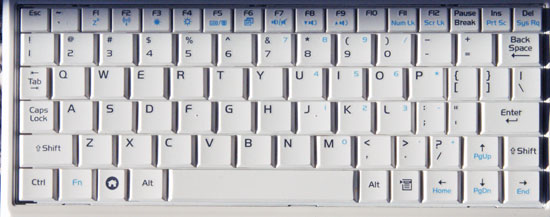
The Eee PC 901 keyboard
All of these netbooks have an insufficient amount of space for a full keyboard, so sacrifices must be made. On the Eee PC ASUS attempted to preserve the standard keyboard layout and just made all of the keys very small. The benefit here is that you know where everything is, and switching between a normal keyboard and the Eee PC isn’t difficult, the downside being that you often fat-finger the keys.
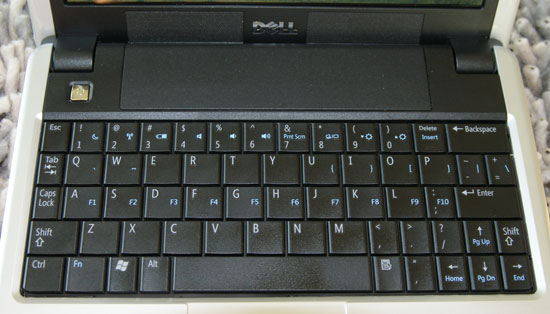
The Inspiron Mini 9 keyboard
Dell chose a different route. It got rid of the row of function keys at the top and reorganized some of the punctuation keys, making the main letter keys significantly larger. On the Inspiron Mini 9 you’re far less likely to mistype a word, but throw in some punctuation (apostrophes, quotes, etc...) and your typing speed/accuracy goes down considerably.
The function keys moved to the home row on the keyboard, which means to close a window using the keyboard you have to hit ALT + Fn + F (which doubles as the F4 key when you hold down the Fn key). Thankfully it’s convoluted and different enough that you won’t get used to it and try to do it on a normal keyboard, and not annoying enough to really be a pain on the Mini. I’d say that’s quite possibly the most frequently used function key combination, the rest don’t really come up as much so I wasn’t too bothered.
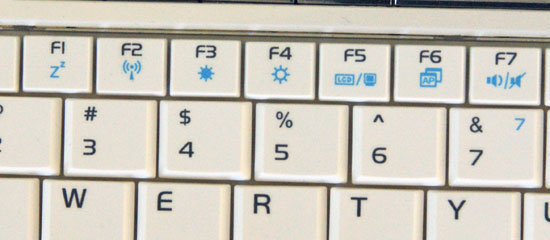
The function keys on the Eee PC's keyboard
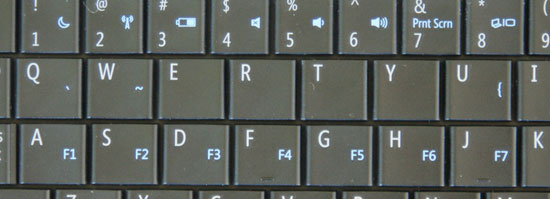
The function keys on the Mini's keyboard, note how they share the same keys as the home row
The keys that really bothered me the most were the hyphen, comma, colon and apostrophe keys. The colon/semicolon key is now directly to the left of the Enter, while the apostrophe/quote key is to the left of the left arrow key. If your big on leaving out apostrophes (see what I did there?) and don’t mind not quoting, ever, then the keyboard is livable. Otherwise, if you’re typing for accuracy, it’ll drive you insane - just in a different way from the Eee PC’s keyboard.
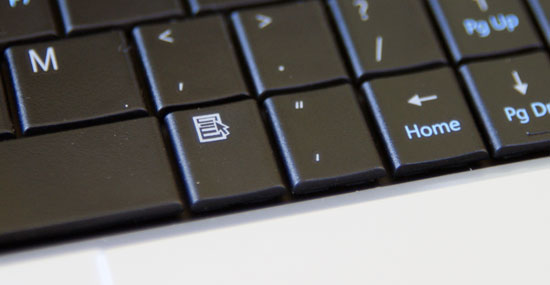
I'm sorry, what are you doing down there?
Dell makes the argument that after about 15 minutes you’ll get used to it. I agree. Except for the fact that in theory you’ll be going back to a normal keyboard at some point, and whichever you use the most will make the other one feel quite awkward. My money is on the fact that you’ll use a normal keyboard more than the Mini, in which case getting used to the funky comma positioning isn’t going to help anything.
That being said, I need to have some sort of a stance here so here it goes: if you’re just having casual IM conversation, facebooking or generally not doing any serious writing, I’d say the preference should be for the Dell keyboard - you can actually type words on it better than you can on the Eee. But for overall typing speed, the ASUS solution is better if you’re going to be switching between your netbook and other keyboards on a regular basis.
|
Apple MacBook Air
|
ASUS Eee PC 901
|
Dell Inspiron Mini 9
|
 |
 |
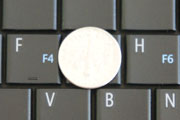 |
The table above should put things in perspective. On the MacBook Air, the dime is about the same size, if not smaller, than a single key. On the Eee PC the dime covers more than just a single key. The Inspiron Mini is closer to the Air than it is the Eee PC in its key sizes.
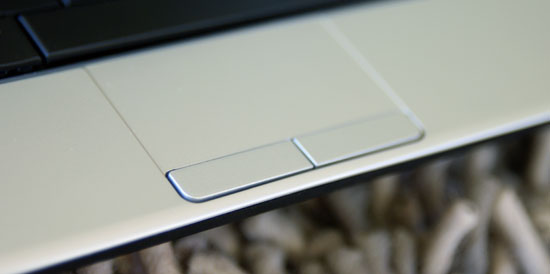
There's a tiny trackpad below the keyboard on the Mini, similar to the Eee PC. The Mini's trackpad supports scrolling, but only with a single finger along the right edge of the trackpad. ASUS' design is much better as you just use two fingers to scroll, with no stipulations on where you have to put them. I suspect that this is more of a cost issue as the Eee PC 901 is priced a good $200 over the Inspiron Mini 9.










55 Comments
View All Comments
Klug - Friday, September 5, 2008 - link
Thanks for the review.Maybe I misread but I could not find any info about the external PSU... How fat is it?
I currently use a M1330 and the external PSU is a pain (big, heavy, thick cable, etc).
Netbook is nice but when used "on the road" (ie: train, meetings, etc), it needs to be carried with its PSU. If the PSU is fat, that's bad.
benlen - Friday, September 5, 2008 - link
I missed this my self. An is a important information an a netbook.I found the answer here: http://www.youtube.com/watch?v=5M37j5BnERw">http://www.youtube.com/watch?v=5M37j5BnERw
about one minute in.
I am happy with the type.
They say it is 2.6 lbs with the psu so the psu should be about 0.4 lbs.
But I still havent found a picture on the UK psu. I hope it will be a travle type where you can change the plugs/connectors
I am by the way selling my M1330 to only have a mini 9 and a stationary
strafejumper - Friday, September 5, 2008 - link
i've been researching lappys for a week trying to buy my first one.found one i love from lenovo 15.4" but the one problem is all 15.4" lappy's that i've been looking at seem to have the exact same florescent lcd and when i went to circuit city to look at some they all looked very dim because of the vertical viewing angle.
Then i was in a local shop and they had a macbook air and it was totally different, many times brighter and still bright even at angles. Looking for a cheaper laptop than the macbook air now that has this good an led lcd. May have to wait a while.
wvh - Thursday, September 4, 2008 - link
Looks interesting, especially the passive cooling... But as someone who works in several countries, I think they made a mistake with their peculiar keyboard layout. It's not easy to get used to all the different international layouts, laptop- vs. full-sized keyboards, model-specific multimedia- and function-keys, and having manufacturers come up with their own proprietary layout on top of that makes their product much less appealing to me.
JoshuaBuss - Thursday, September 4, 2008 - link
nice carpet, anand! :)alpine18 - Thursday, September 4, 2008 - link
The dell sounds interesting, but I'll keep my eeepc 901 for now. I love this thing.It is great to see so many new netbooks in the market place. When they come out with a new netbook with the dual-core Atom, I'll probably buy one.
I differ with the article author's view on battery life and use. My eee 901 has effectively replaced my full size Gateway laptop. The thing sits at home since I got my 901, little more than a glorified portable desktop. I use my 901 all day without having to recharge, take it to meetings so I can act like I am taking notes when I am actually catching up on other work.
For me, the deal breaker for the Dell would be the battery life and 1GB memory. I have 2GB of memory in my 901 and need the 5-8 hours of battery life. If the Dell had the same battery life as the 901 and was upgradeable to 2GB, I'd seriously be thinking about getting one.
MamiyaOtaru - Thursday, September 4, 2008 - link
Glossy Screen? Why? So I can see what's behind me better than what I'm working on? Especially for a portable computer that just might be used outside, a reflective screen is dumb.I know glossy screens sell better in brick and mortar stores, but people are dumb (ooh, shiny!)
Nice to have a choice I suppose, so those who like it can get the Dell and I can get something else. But that's my point really, I'd get something else.
abakshi - Thursday, September 4, 2008 - link
Dell seems to have done better than I expected, but I'd be curious to see how you'd compare with the HP 2133 Mini-Note in terms of build quality, keyboard, screen, etc.I have a Mini-Note (C7 1.6 / 2GB / 120GB 7200rpm / Vista Business), and while granted, most configs are priced higher than the average netbook, the design is awesome and it's built better than any HP/Dell/etc. laptop I've ever seen. More importantly, the keyboard's light-years ahead of the EeePC and all other netbooks I've encountered thus far, and with a nice bright 1280x768 screen, it's a pleasure to work with on the go.
Roy2001 - Thursday, September 4, 2008 - link
1. Dual core Atom.2. Power saveing Poulsbo chipset + HD decoding feature.
3. Smooth HD/BD movie play back.
4. Has at least 8GB SSD built in and a SDHC slot so I can insert a cheap 32GB SD card (some day) as 2nd HD.
5. Has mini-HDMI output.
5. Built-in camera should be standard.
6. 1GB RAM should be standard.
7. 10" LCD with 1280x800 resolution.
8. Bluetooth built in so I can use a wireless mouse/keyboard without a dongle.
The more I can dream is touch screen, wireless USB hub, and more...
Matt Campbell - Thursday, September 4, 2008 - link
I'm really impressed with what Dell has done with the Mini, they struck a great balance with price/features and it looks fantastic. Thanks for the suggestions - the Wind, Aspire and Lenovo S10 are on my review wish list as well. Keep your eyes peeled for an upcoming HP 2133 Mini-Note review. Hopefully between Anand, Jarred and I we'll cover everything eventually :)